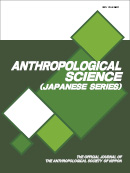Volume 128, Issue 1
Displaying 1-6 of 6 articles from this issue
- |<
- <
- 1
- >
- >|
Review
-
Article type: Review
2020Volume 128Issue 1 Pages 1-19
Published: 2020
Released on J-STAGE: June 23, 2020
Advance online publication: April 07, 2020Download PDF (1791K)
Original Article
-
Article type: Original Article
2020Volume 128Issue 1 Pages 21-37
Published: 2020
Released on J-STAGE: June 23, 2020
Advance online publication: April 16, 2020Download PDF (2109K)
Book Reviews
-
Article type: Book Review
2020Volume 128Issue 1 Pages 39
Published: 2020
Released on J-STAGE: June 23, 2020
Advance online publication: March 20, 2020Download PDF (640K) -
Article type: Book Review
2020Volume 128Issue 1 Pages 41-43
Published: 2020
Released on J-STAGE: June 23, 2020
Advance online publication: April 08, 2020Download PDF (880K)
Japanese Summaries of Papers Published in Anthropological Science (English Series)
-
Article type: Japanese Summaries of Papers Published in Anthropological Science (English Series)
2020Volume 128Issue 1 Pages 45-50
Published: 2020
Released on J-STAGE: June 23, 2020
Download PDF (2002K)
Presentation Summaries of ASN Young Scientist Oral Presentation Award
-
Article type: Presentation Summaries of ASN Young Scientist Oral Presentation Award
2020Volume 128Issue 1 Pages 51-54
Published: 2020
Released on J-STAGE: June 23, 2020
Download PDF (1149K)
- |<
- <
- 1
- >
- >|
